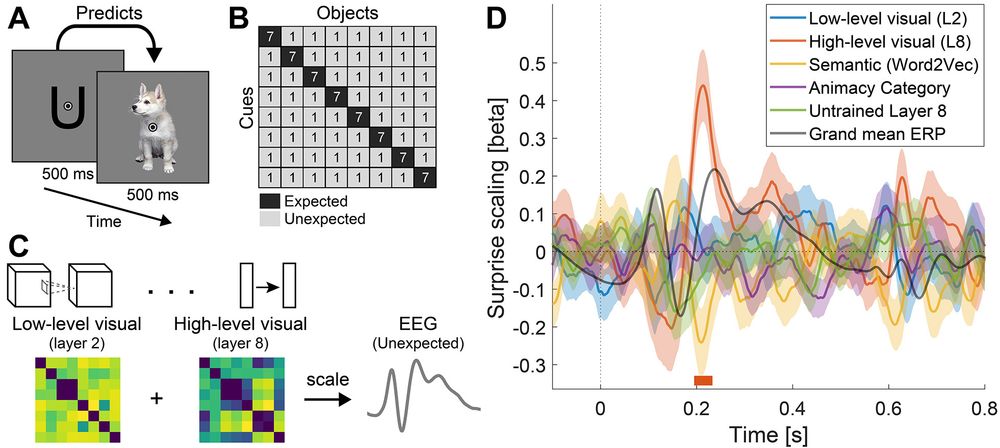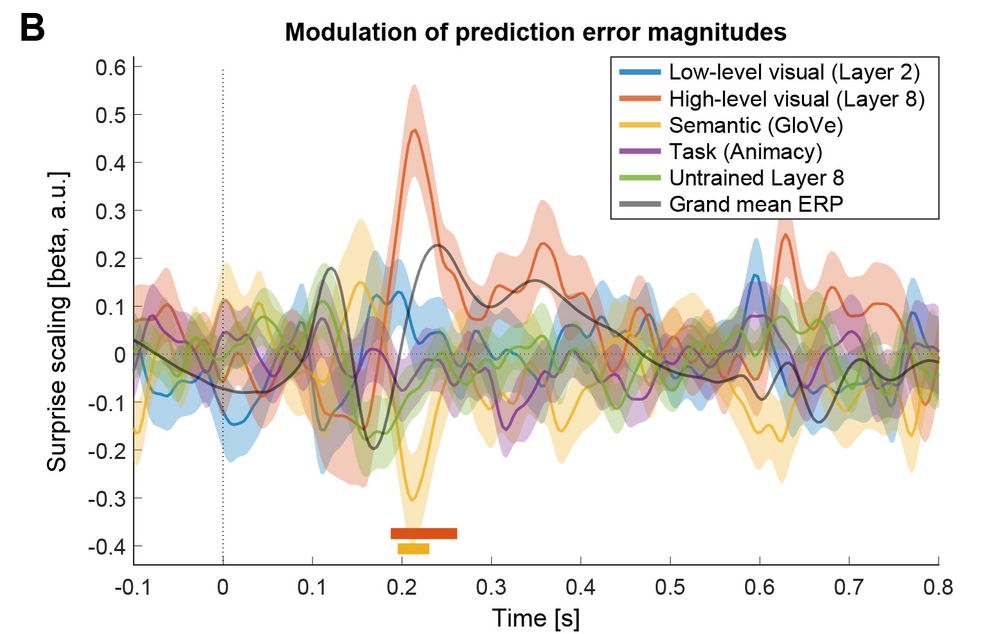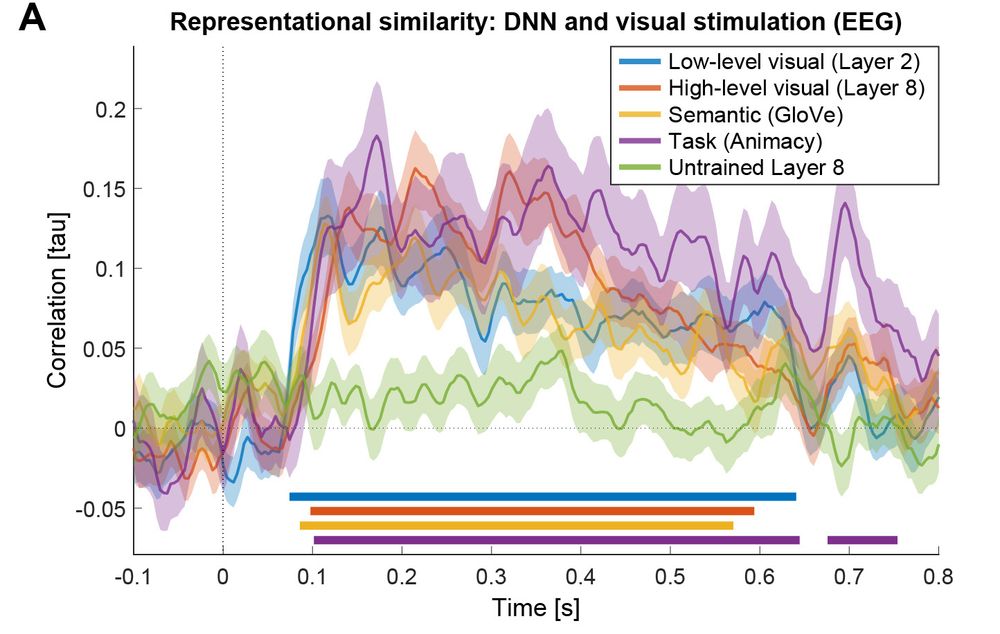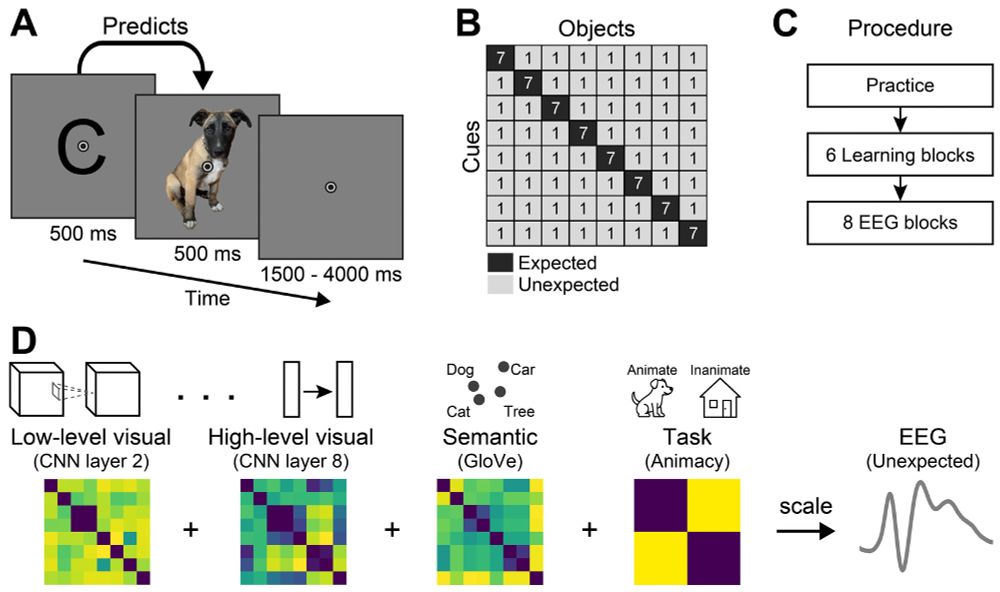Redirecting
If you’re interested in more details, check out the full paper:
doi.org/10.1016/j.is...
05.12.2025 14:37 — 👍 1 🔁 0 💬 0 📌 0
Taken together, our findings show that high-level visual predictions are rapidly integrated during perceptual inference, suggesting that the brain's predictive machinery is finely tuned to utilize expectations abstracted away from low-level sensory details to facilitate perception.
05.12.2025 14:37 — 👍 1 🔁 0 💬 1 📌 0
We also found a small decrease in neural responses by semantic (word-based) surprise. Notably, low-level visual surprise had no detectable effect, even though stimuli were predictable all the way down to the pixel level.
05.12.2025 14:37 — 👍 0 🔁 0 💬 1 📌 0

Then we turned to the key questions: When and what kind of surprise drives visually evoked responses?
Neural responses ~190 ms post-stimulus onset over parieto-occipital electrodes were selectively increased by high-level visual surprise!
05.12.2025 14:37 — 👍 0 🔁 0 💬 1 📌 0

As a sanity check, we first used RSA to show that the CNN and other models of interest (semantic and task models) robustly explained the EEG responses independent of surprise.
05.12.2025 14:37 — 👍 0 🔁 0 💬 1 📌 0

We investigated these questions using EEG and a visual CNN. Participants viewed object images that were probabilistically predicted by preceding cues. We then quantified surprise trial-by-trial at low-levels (early CNN layers) and high-levels (late CNN layers) of visual feature abstraction.
05.12.2025 14:37 — 👍 0 🔁 0 💬 1 📌 0
Predictive processing theories propose that the brain continuously generates predictions about incoming sensory input.
But what exactly does the brain predict? Low-level (edges, contrasts) and/or high-level visual features (textures, objects)?
And when do these predictions shape neural responses?
05.12.2025 14:37 — 👍 0 🔁 0 💬 1 📌 0

Rapid computation of high-level visual surprise
Health sciences
High-level visual surprise is rapidly integrated during perceptual inference!
🚨 New paper 🚨 out now in @cp-iscience.bsky.social with @paulapena.bsky.social and @mruz.bsky.social
www.cell.com/iscience/ful...
Summary 🧵 below 👇
05.12.2025 14:37 — 👍 13 🔁 7 💬 2 📌 0

Contents of visual predictions oscillate at alpha frequencies
Predictions of future events have a major impact on how we process sensory signals. However, it remains unclear how the brain keeps predictions online in anticipation of future inputs. Here, we combin...
@dotproduct.bsky.social's first first author paper is finally out in @sfnjournals.bsky.social! Her findings show that content-specific predictions fluctuate with alpha frequencies, suggesting a more specific role for alpha oscillations than we may have thought. With @jhaarsma.bsky.social. 🧠🟦 🧠🤖
21.10.2025 11:05 — 👍 92 🔁 38 💬 4 📌 2

If you’re into predictive processing and curious about the ‘what & when of visual surprise’, come see me at #CCN2025 in Amsterdam!
Poster B23 · Wednesday at 1:00 pm · de Brug.
11.08.2025 15:46 — 👍 16 🔁 2 💬 0 📌 0
Hi, we will have three NeuroAI postdoc openings (3 years each, fully funded) to work with Sebastian Musslick (@musslick.bsky.social), Pascal Nieters and myself on task-switching, replay, and visual information routing.
Reach out if you are interested in any of the above, I'll be at CCN next week!
09.08.2025 08:13 — 👍 58 🔁 31 💬 0 📌 1

UCL – University College London
UCL is consistently ranked as one of the top ten universities in the world (QS World University Rankings 2010-2022) and is No.2 in the UK for research power (Research Excellence Framework 2021).
We are recruiting a new PI at the FIL @imagingneuroucl.bsky.social, Associate or Full Professor. This is an amazing place to do cognitive neuroscience, in the heart of London. If you or someone you know might be interested, please pass it on. #neuroskyence
www.ucl.ac.uk/work-at-ucl/...
08.08.2025 10:52 — 👍 58 🔁 69 💬 0 📌 2
If you are interested in pursuing a PhD in cognitive neuroscience, specially targeting conscious vs. unconscious processing, contact me. We are recruiting 🙏🧠 please RT
21.07.2025 11:50 — 👍 38 🔁 29 💬 0 📌 2
Postdoc Position – FLARE Project
🚨 We’re hiring a postdoc!
Join the FLARE project @cimcyc.bsky.social to study sudden perceptual learning using fMRI, RSA, and DNNs.
🧠 2 years, fully funded, flexible start
More info 👉 gonzalezgarcia.github.io/postdoc/
DMs or emails welcome! Please share!
18.07.2025 11:17 — 👍 22 🔁 22 💬 1 📌 3
Exciting new preprint from the lab: “Adopting a human developmental visual diet yields robust, shape-based AI vision”. A most wonderful case where brain inspiration massively improved AI solutions.
Work with @zejinlu.bsky.social @sushrutthorat.bsky.social and Radek Cichy
arxiv.org/abs/2507.03168
08.07.2025 13:03 — 👍 139 🔁 59 💬 3 📌 11
Taken together, our findings demonstrate that high-level visual predictions are rapidly integrated during perceptual inference. This suggests that the brain's predictive machinery is finely tuned to utilize expectations abstracted away from low-level sensory details, likely to facilitate perception.
26.06.2025 10:22 — 👍 1 🔁 0 💬 1 📌 0
We also found a curious decrease in ERP amplitude by semantic (word-based) surprise. Critically, we found no modulation by low-level visual surprise, even though stimuli were predictable all the way down to the pixel level.
26.06.2025 10:22 — 👍 0 🔁 0 💬 1 📌 0

Next, we turned to the key questions – when and what kind of surprise drive visually evoked responses? Results showed that neural responses around 200ms post-stimulus onset over parieto-occipital electrodes were selectively enhanced by high-level visual surprise.
26.06.2025 10:22 — 👍 0 🔁 0 💬 1 📌 0

First, as a sanity check, we used RSA to show that the DNN and other models of interest (a semantic word-based and a task model) well explained the EEG response irrespective of surprise.
26.06.2025 10:22 — 👍 0 🔁 0 💬 1 📌 0

We investigated these questions using EEG and a visual DNN. Participants viewed object images that were probabilistically predicted by preceding cues. We then quantified trial-by-trial surprise at low-levels (early DNN layers) and high-levels (late DNN layers) of visual feature abstraction.
26.06.2025 10:22 — 👍 0 🔁 0 💬 1 📌 0
Predictive processing holds that the brain continuously generates predictions about incoming sensory information. But at what level of abstraction does the brain predict – edges & contrasts or high-level textures & objects? And which stages of visual processing do such predictions modulate?
26.06.2025 10:22 — 👍 0 🔁 0 💬 1 📌 0
The what and when of visual surprise:
EEG shows that high-level visual surprise emerges rapidly and modulates neural responses ~200ms after stimulus onset.
New preprint with @paulapena.bsky.social and @mruz.bsky.social available here: doi.org/10.1101/2025...
Summary 🧵 below
26.06.2025 10:22 — 👍 23 🔁 9 💬 1 📌 0

Out now @cp-trendscognsci.bsky.social, w/ @akalt.bsky.social & @drmattdavis.bsky.social.
Are sensory sampling rhythms fixed by intrinsically-determined processes, or do they couple to external structure? Here we highlight the incompatibility between these accounts and propose a resolution [1/6]
19.06.2025 11:18 — 👍 70 🔁 31 💬 3 📌 1

PhD Studentship: Public Communication and Private Confidence at Birkbeck, University of London
Find a PhD Studentship: Public Communication and Private Confidence on jobs.ac.uk, the top job board in higher education. Click to view more!
Looking for a PhD in #psychology or #cogneuro ? I’m recruiting a fully-funded @leverhulme.ac.uk PhD student to join my lab at @birkbeckpsychology.bsky.social. If you’re interested in metacognition, learning, social cognition and culture I’d love you to apply 🧠👇
www.jobs.ac.uk/job/DNJ330/p...
06.06.2025 12:07 — 👍 21 🔁 18 💬 2 📌 1
I am so excited to share that our paper 'A neural basis for distinguishing imagination from reality' is now published in @cp-neuron.bsky.social! 🧠✨ See thread below! doi.org/10.1016/j.ne...
05.06.2025 15:04 — 👍 177 🔁 67 💬 8 📌 8
Introducing All-TNNs: Topographic deep neural networks that exhibit ventral-stream-like feature tuning and a better match to human behaviour than the gold standard. Now out in Nature Human Behaviour. 👇
06.06.2025 11:00 — 👍 41 🔁 8 💬 1 📌 0
PhD position in biological foundations of neural control
PhD position in biological foundations of neural control
PhD position alert!!!
Together with @predictivebrain.bsky.social and Sonja Kotz we are looking for a PhD candidate to join a great project on the biological foundations of perceptual decisions vacancies.maastrichtuniversity.nl/job/Maastric...
Happy to answer any question you may have!
03.06.2025 04:54 — 👍 16 🔁 13 💬 1 📌 0
iScience is the interdisciplinary journal from Cell Press publishing across life, physical, earth, health, and social sciences.
Dedicated to helping neuroscientists stay current and build connections. Subscribe to receive the latest news and perspectives on neuroscience: www.thetransmitter.org/newsletters/
#firstgen 🇨🇦 Assistant Professor @LoyolaChicago - The MNEME Lab: studying memory and neuromodulatory mechanisms • beh-systems neuro • stress, anxiety, addiction • she/her • stephaniegrella.com
Professor @ Temple University: neuro/psycholinguistics, semantic memory, dementia, neurorehabilitation, nlp, pupillometry, photography, art, horror
Mood & Memory researcher with a computational bent. https://www.nicolecrust.com. Science advocate. Prof (UPenn Psych) - on leave as a Simons Pivot Fellow. Author: Elusive Cures. https://press.princeton.edu/books/hardcover/9780691243054/elusive-cures
Neuroscientist | Assistant Professor at the Hebrew University, Psych department | Studying belief updating and placebo effects with models and brains | Trying to make science more open.
Neuroscientist, in theory.
Studying sleep and navigation in 🧠s and 💻s.
Wu Tsai Investigator, Assistant Professor of Neuroscience at Yale.
An emergent property of a few billion neurons, their interactions with each other and the world over ~1 century.
Postdoc @ Charite, Berlin w/ Matthew Larkum
Former PhD student @ NIN, Amsterdam w/ Christiaan Levelt.
Predictive coding, sleep, inhibition, chandelier cells, cortical coupling
MSCA postdoc @ Predictive Brain Lab - Donders Insitute • language acquisition • neurobiology of language • open science • she/her
Neuroscience Editor and Section Manager at PLOS Biology #OpenScience
How does the brain work and what's happening when things go wrong?
Postdoctoral researcher, studying belief-based exploration and (un)predictability in biological and artificial agents
https://thirzadado.com/
Depts. of Psychology & Psychiatry, U. Wisconsin–Madison
Editor-in-Chief, Journal of Cognitive Neuroscience
Director, Psychology Research Experience Program (summer program for URM/low-income/1st-gen undergrads)
PhD candidate at the Predictive Brain Lab, Donders Centre for Cognitive Neuroimaging / University of Amsterdam. I study predictive processing in natural perception using Neuro-AI.
Assoc prof @UDelaware | social neuroscientist interested "us vs them" and "human vs AI" | Mexican, Indigenous, Japanese First Gen | #UDPBS | @UDPOSCIR | 🧠
https://www.ifsnlab.org/
Associate Professor, Department of Psychology, Harvard University. Computation, cognition, development.
Professor of biological psychology
@unigreifswald.bsky.social. Member @jungeakademie.bsky.social.
https://psychologie.uni-greifswald.de/43051/biologische-psychologie/prof-dr-jakub-limanowski/
Assistant professor at @KU_Leuven, working on #confidence, #decisionmaking and #cognitivecontrol => DesenderLab.com
Studying natural vision at JLU Giessen using psychophysics, neuroimaging, and computational models, PI: Daniel Kaiser.
danielkaiser.net














